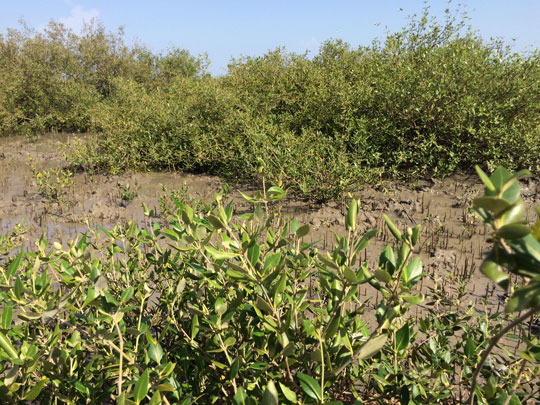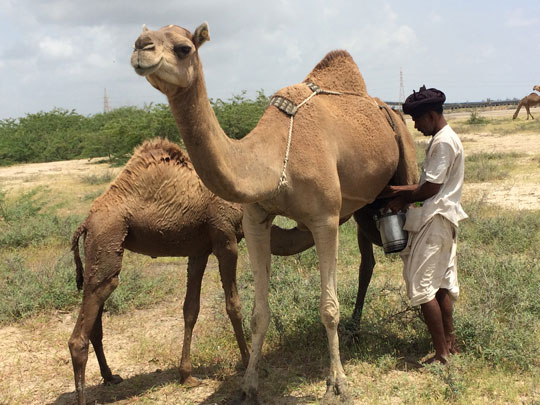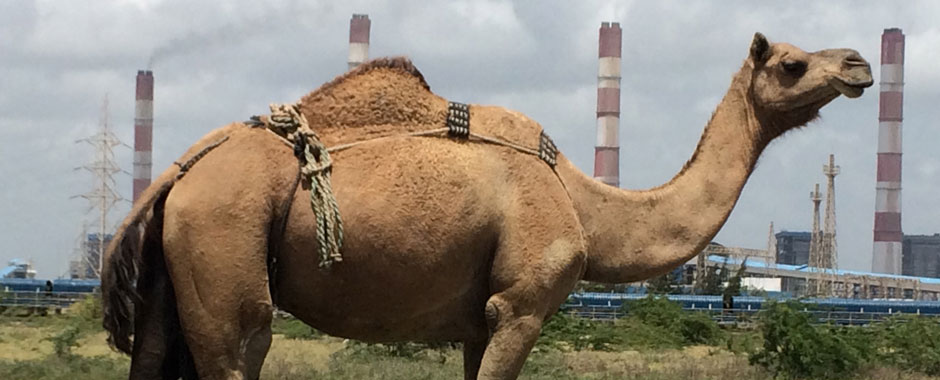There is a real buzz about Mundra village on the Gulf of Kachchh coast, one of the fastest growing industrial hubs in India. A sprawling port, two of India’s biggest thermal power plants, and a special economic zone with growing export industries jostle for space in what once used to be western India’s biggest stretch of mangroves. Amidst these rapid changes, the livelihoods and lifestyles of local fisherfolk, and cattle and camel herding communities, are undergoing some dramatic shifts.
A STEPS research project looks at three dimensions of these changes: how local villagers use these mangroves for fishing, fodder, fuel and as a bioshield against storms and high tides; the changes in these socio-ecological systems; and the conflicts of interests amidst various stakeholders involved.
Growing on the margins between the land and the sea, mangroves support a wealth of life in tropical and sub-tropical coasts – microbes and fungi, honeybees, birds, plants feed fish, crabs, cattle and camels.

Mangroves. Photo: Max Martin
Mangroves are considered wonder plants. Their complex roots filter out salt, prop up the plants on the soft sediment between the tidelines, and mesh out and interlock, holding the mudflats tight against waves and tides. Their trunks and stems provide a buffer for coastal habitats against storm surges and high tides. Some plants like the hardy staple of Kachchh called grey mangrove or Avicennia marina have snorkel-like aerial roots that help them breath from above the water surface.
How life is changing in Kachchh
While on a field visit in Kachchh during August-September 2016, the STEPS team noticed some clear trends. First, several communities of cattle and camel herders and fisherfolk, who have depended on mangroves for centuries, are now getting edged out as industries expand. Second, large tracts of mangroves are being destroyed, degraded or fragmented, despite a set of large-scale, industry- and government-sponsored afforestation programmes. Third, there are conflicting interests among different stakeholders, including corporates, the state Forest Department, camel herders and fisherfolk.
Our field visits covered two major concentrations of mangroves in Kachchh, namely Mundra and Jakhau. The villagers told us how the mangroves became their lifelines. This extent of dependence is unique in Kachchh, where 789 sq km of mangroves account for 17% of the country’s total mangrove area. It’s the biggest forest area of its kind after the Sundarbans on the east coast.
In Kachchh, the nomadic pastoralist communities of Rabaris and Jats (pronounced ‘Jaath’, and not to be confused with the Jats of northern India) keep a local camel breed called Kharai (salty) that feed on the mangroves. They swim across the coastal waters to small forest islands to graze.
Studies show that the number of Kharai camels (along with that of the inland breed of Kachchhi camels) have dwindled as their grazing grounds have shrunk.
Camels and mangroves
At Asira Vandh, a hamlet near Jakhau inhabited by the Jat community, we saw women visiting the mangroves early in the morning in a hired tractor trailer to collect mangrove leaves and stems to feed their camels and buffaloes.
Muslims who have migrated from Baluchistan (where they came from Central Asia), Jats of Asira Vandh follow a Sufi saint and are called Fakirani Jats. They were primarily camel herders, but have diversified into buffalo and goat rearing and fishing of late. Camels are no longer the workhorses of the desert as they once used to be. Kachchh is an arid and semi-arid place, and the space occupied by the 170km wide Gulf of Kachchh was a desert long ago.
In the dry conditions of Kachchh, the mangroves provide enough fodder. A recent study showed that 96 per cent of the households in Asira Vandh depended on mangroves for their livelihood, saving them the trouble of buying fodder from the market. The local people, however, said they rarely use mangroves for fuel, as they get enough Gando baval (Prosopis juliflora), a wild plant that comes from Central and South America and has spread as an invasive weed even in the arid areas of Kachchh.
The villagers actively participated in a mangrove regeneration project of the Gujarat Ecology Commission, with technical support from the Gujarat Institute of Desert Ecology (GUIDE), a leading research centre in Bhuj. The villagers said the initiative helped them save their livelihoods as they get enough fodder now.
Close to Mundra, at Tunda Vandh, Rabari nomadic pastoralists are not as lucky as their counterparts in Asira Vandh. They have to herd their camels across a stretch of power plants and industries to fragmented patches of degraded mangroves, and along the edges of a fast-track highway to the creek of Rand Bandar (harbour), a fisher-folk’s campsite.

Rabari herder with camel. Photo: Max Martin
The industries allow them with permits and passes, though plantations in the nearby Luni village are out of bounds for them. The fisherfolk who plant mangroves on an industry-sponsored project say they try to chase the camel away, but the Rabaris resist. The Rabaris, on the other hand, say they are helpless as their camels have to survive.
At the harbour, however, the fisherfolk welcome the Rabaris and their camels to the fullgrown natural mangroves along the creek. As the local wisdom goes, when the camels graze the top foliage, the mangrove plants get cropped, allowing renewed growth. Besides, the camels stamp on the seeds, embedding them firmly in the mudflats and helping them to grow.
Fishing and mangroves
Traditionally, fisherfolk believe that there are more fish in mangroves than in bare creeks. Mangroves are also home to a rich variety of mudskippers, crabs, bivalves, gastropods, fish, and other species. “Fish come to the mangroves to breed, so we get a rich haul,” said an elderly fisherman who coordinates the mangrove regeneration efforts. The fisherfolk also call them a ‘bio-shield’.
In Asira Vandh, Bhadreswar and Rand Bandar the local fisherfolk said that the the mangroves partly protected their homes from the 1998 cyclone in Kachchh. At the same time the storm surge also uprooted huge tracts of mangrove forests.
Mangroves under threat
Fisherfolk and cattle and camel herders in Kachchh contribute to regeneration efforts, but they are concerned that mangrove ecosystems are increasingly threatened as industries and ports expand. Construction, routine maintenance, dredging and even vessel movement to the ports affect the mangroves. In short, pressures on these ecosystems are many: overgrazing, timber and fuel wood harvest, erosion of the shoreline, uncertain and sparse rainfall, industrial effluents, chemical pollution, maritime traffic and mechanized fishing. In future, mangroves are likely to shrink even more as sea levels gradually rise.
One of the results has been a drastic reduction in camel herds. Camel-rearing communities often have to travel great distances with their herds in search of grazing grounds. At Tunda Vandh, the villagers said that they have reduced the number of camels to about 600, many of them camping in faraway grazing sites. Elders say that three decades ago there were 10,000 camels, though local researchers estimate much lower figures.
As grazing fields shrink, camels are commonly left in faraway fields. At Nimdi Vandh in Lakh pat taluka, a Jat hamlet with about 30 households, the villagers said they look after 150 camels belonging to Rabaris from elsewhere, and let them graze in the local mangroves. The households that look after the camels could use the milk and earn a fee for keeping the animal. Rabaris visit the place occasionally and take away mature camels for sale.
Regeneration efforts
While communities feel the pressure of mangrove degradation, there have been massive efforts to regenerate these ecosystems. The Gujarat Ecology Commission (GEC) coordinates most of these initiatives, using community-based models. Studies using satellite images from the early 1990s to 2016 show a twofold increase in mangrove areas. Still scientists note that, of the 30,000 hectares of plantations, half can be described as having failed. As such, mangroves in Kachchh are sparse because of the harsh climate and environment. Even so, the government is aggressively promoting more mangrove afforestation – the latest initiative being a World Bank project covering 20,000 ha in Kachchh and elsewhere along the Gulf of Kachchh.
GUIDE scientists note that the regenerated mangrove system takes years to yield environmental benefits, especially in a harsh environment like Kachchh. The villagers therefore often lose interest in an externally controlled, long-drawn-out process that does not give them short-term benefits. In Tunda Vandh, a place where fisherfolk get free healthcare, water supplies, free children’s education and transport as part of a CSR programme from the multinational Adani Group, the villagers complain about the low wages they get from the mangrove plantation programme. Meanwhile, in Luni and Bhadreshwar, there is conflict between the fisherfolk who own boats and those who fish largely from the shore and shallow waters of the creek. While the boat owners would like the creek to be dredged and deepened, the shoreline fisherfolk prefer the current environment that makes it easier for them to fish.
Scientists working in the area suggest more imaginative community-owned systems of mangrove regeneration, especially making use of opportunities under the Clean Development Mechanism and REDD, and acknowledging the carbon sequestration potential of the mangroves. Research shows that a unit area of mangrove can absorb more carbon dioxide that most other forests. Future research could consider the role of mangroves as an environmental good, especially in the context of climate change, and the opportunities and challenges they offer, even amidst the conflicts over their use.
Header photo: Kharai camel, by Max Martin
Max Martin is a researcher with the project Market-based mangrove afforestation and reforestation in Kenya and India. He is an associate tutor in the Department of Geography at the University of Sussex, UK.
